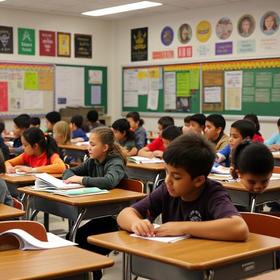Manhattan Village Academy is a small, public high school located in the Flatiron District, New York City. It consists of grades 9–12 with an enrollment of 461 students. The school is part of the New York City Department of Education. The school was founded by veteran educator Mary Butz in 1993.
Serving 400 students in grades 9-12, Manhattan Village Academy ranks in the top 20% of all schools in New York for overall test scores (math proficiency is top 20%, and reading proficiency is top 20%).
The percentage of students achieving proficiency in math is 70-74% (which is higher than the New York state average of 52%). The percentage of students achieving proficiency in reading/language arts is 60-64% (which is higher than the New York state average of 49%).
The student-teacher ratio of 11:1 is equal to the New York state level of 11:1.
Minority enrollment is 87% of the student body (majority Hispanic), which is higher than the New York state average of 60% (majority Hispanic and Black).
Quick Facts (2025-26)
- Grades: 9-12
- Enrollment: 400 students
- Student-Teacher Ratio: 11:1
- Minority Enrollment: 87%
- Graduation Rate: ≥95% (Top 10% in NY)
- Overall Testing Rank: Top 20%
- Math Proficiency: 70-74% (Top 20%)
- Reading Proficiency: 60-64% (Top 30%)
- Science Proficiency: ≥95% (Top 5%)
- Source: National Center for Education Statistics (NCES), NY Dept. of Education
Top Rankings
Manhattan Village Academy ranks among the top 20% of public schools in New York for:
Category
Attribute
Overall Rank
Math Proficiency
Science Proficiency
Graduation Rate
Diversity
School Overview
Manhattan Village Academy's student population of 400 students has declined by 11% over five school years.
The teacher population of 36 teachers has grown by 20% over five school years.
Grades Offered
Grades 9-12
(Supplemental Virtual)
(Supplemental Virtual)
Total Students
400 students
Gender %
Total Classroom Teachers
36 teachers
Year Founded
1905
Colors
Grey, Navy Blue
Last Day of School
Mon. May 25, 2026
Campus Size
50 acres
School Motto
'Truth and Honor'
School Mascot
Wild Boars
School Rankings
Manhattan Village Academy ranks within the top 20% of all 4,346 schools in New York (based off of combined math and reading proficiency testing data).
The diversity score of Manhattan Village Academy is 0.66, which is less than the diversity score at state average of 0.72. The school's diversity has stayed relatively flat over five school years.
Overall Testing Rank
#867 out of 4346 schools
(Top 20%)
(Top 20%)
Math Test Scores (% Proficient)
70-74%
52%
Reading/Language Arts Test Scores (% Proficient)
60-64%
49%
Science Test Scores (% Proficient)
≥95%
78%
Student-Teacher Ratio
11:1
11:1
American Indian
1%
1%
Asian
17%
10%
Hispanic
53%
30%
Black
15%
16%
White
13%
40%
Hawaiian
n/a
n/a
Two or more races
1%
3%
All Ethnic Groups
Graduation Rate
≥95%
87%
Participates in the National School Lunch Program (NSLP)
Yes
Eligible for Free Lunch
63%
54%
Eligible for Reduced Lunch
7%
3%
School Statewide Testing
School District Name
Source: National Center for Education Statistics (NCES), NY Dept. of Education
School Notes
- School Mascot: Wild Boars
Profile last updated: 02/09/2025
Frequently Asked Questions
What is Manhattan Village Academy's ranking?
Manhattan Village Academy is ranked #867 out of 4,346 schools, which ranks it among the top 20% of public schools in New York.
What percent of students have achieved state testing proficiency in math and reading?
70-74% of students have achieved math proficiency (compared to the 52% NY state average), while 60-64% of students have achieved reading proficiency (compared to the 49% NY state average).
What is the graduation rate of Manhattan Village Academy?
The graduation rate of Manhattan Village Academy is 95%, which is higher than the New York state average of 87%.
How many students attend Manhattan Village Academy?
400 students attend Manhattan Village Academy.
What is the racial composition of the student body?
53% of Manhattan Village Academy students are Hispanic, 17% of students are Asian, 15% of students are Black, 13% of students are White, 1% of students are American Indian, and 1% of students are Two or more races.
What is the student-teacher ratio of Manhattan Village Academy?
Manhattan Village Academy has a student ration of 11:1, which is equal to the New York state average of 11:1.
What grades does Manhattan Village Academy offer ?
Manhattan Village Academy offers enrollment in grades 9-12 (Supplemental Virtual).
What school district is Manhattan Village Academy part of?
Manhattan Village Academy is part of New York City Geographic District # 2.
School Reviews
5 10/10/2025
MVA is a school the encourages and pushes respect, reason and responsibility. The teachers are there to support the students and give them what they need to move on in this world. Although not many extracurricular activities the students seem to keep on top of their studies and enjoy coming to the school. As a member of the PTA, we look forward to parents joining and helping the school to continue to be one of the best in the city.
3 10/10/2025
MVA school is ok and it`s really hard to be strict but they force you and then you got to do it.
Review Manhattan Village Academy. Reviews should be a few sentences in length. Please include any comments on:
- Quality of academic programs, teachers, and facilities
- Availability of music, art, sports and other extracurricular activities
Recent Articles

How Public Schools Support Students on Free / Reduced-Lunch Programs
Explore how U.S. public schools support students eligible for free or reduced-price lunch through nutrition, academic, and wraparound services in 2025.

Hidden Costs of Public Schools: Fees, Supplies & Extras
Explore the hidden costs in public schools—fees, supplies, extracurriculars—and how parents can plan for them in 2025.

Public School Funding 2025: What Families Should Know
Essential insights on public school funding in 2025—how it works, what’s changing, and what families should know to stay ahead.









